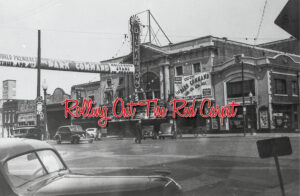The Garden Gate is Still Open
| 2018 Q3 | story by Patricia A. Michaelis, Ph.D., Historical Research

The Outlook
Before donating it to the University of Kansas (KU) for the chancellor’s residence, J.B. and Elizabeth Watkins left the garden gates of their home, the Outlook, open to provide a shortcut for students walking up the hill to campus. Many believe this was just one way Elizabeth Watkins provided encouragement to students. Elizabeth Miller Watkins and her husband, Jabez Bunting (J.B.), shared their wealth with Lawrence and the University in numerous ways, and that generosity still impacts the community.
Elizabeth (Lizzie Jo as she was known to her family) Miller was born in 1861 in New Paris, Ohio, where her father, Valentine Miller, was a physician. When she was 11, her father joined the Union Army, in which he served as a surgeon during the Civil War. In 1872, the family moved to Lawrence, Kansas, where he set up a medical practice. Elizabeth dreamed of attending KU and enrolled in the preparatory school when she was 14. However, her family’s financial difficulties forced her to drop out. At 15, she got a job working for the J.B. Watkins Land and Mortgage Co. She was employed as a clerk but soon promoted to assistant secretary. She eventually became J.B.’s private secretary. The original company’s business was buying land and providing mortgages to other buying land. One of her responsibilities was buying land, traveling on her own to accomplish this. She also frequently traveled with her employer on similar trips, raising some eyebrows by traveling unchaperoned with a man 16 years older than she was. J.B. attracted investors from the east and foreign companies. From 1873 to 1893, J.B. obtained about 2,500 farms through foreclosures, establishing his farmland holdings. Foreclosures were a product of the times, but only 10 to 20 percent of the mortgages made by J.B. ended in foreclosure.
J.B.’s business grew into an empire, with offices in Dallas, New York, London and Lake Charles, Louisiana. In the 1880s, J.B. purchased nearly 1.5 million acres in Louisiana and built railroads throughout the state. He also got into the banking business, including Watkins National Bank, in Lawrence. The current building was built in 1888. Elizabeth worked on the third floor for the Land and Mortgage Co. The bank occupied the second floor, and the first floor was used as an office for lawyers and civic groups.
In 1909, Elizabeth married her boss of more than 30 years in Brooklyn, New York. A brief article in the Lawrence Journal World contained the following announcement:
- Word has reached Lawrence today from New York of the marriage there last week of Miss Lizzie Miller and Mr. J.B. Watkins, both of this city. This announcement is the most startling that has been made in Lawrence in several years, for no one in Lawrence had any idea that the wedding was to take place.
A former director of the Watkins Museum, Steve Jansen believed that Lizzie and J.B. had been romantically involved for most of the time she was his secretary. In addition to accompanying him on long trips, he bought life insurance policies for her and provided for her in his will prior to their marriage. He also believed that the delay in the marriage was because Lizzie’s parents were strong prohibitionists, and J.B. drank heavily. Lizzie’s mother died in 1909, and the couple married that same year.
Despite their wealth, Lizzie and J.B. were not included by the city’s elite in social events. They built their mansion, the Outlook, at the end of Lilac Lane three years after their marriage. The three-story Neoclassical Revival mansion had 26 rooms, seven fireplaces and 17 closets, with porches and verandas on every side of the home. Ionic columns graced the front entrance. The more than 6,000-square-foot residence had white stucco walls and a green clay tile roof. The style of the home was called “Prairie Newport.”
They only lived in home together for nine years. J.B. died in 1921 at the age of 76. Elizabeth told the Kansas City Star she and J.B. had discussed many things they wanted to do with their wealth but had not finalized their plans. Having created his own fortune of $2.4 million, J.B. did not want to leave it to his relatives even though he believed they expected to receive it. The estate included seven corporations, 200 Kansas companies, more than 200 Kansas farms and over 100,000 acres of land in Texas and Louisiana.
Before J.B.’s death, the couple had been providing financial assistant to hundreds of KU students. The Watkins’s wanted to provide a “hand up,” rather than a “hand out,” to allow students opportunities to improve themselves.
On July 1, 1925, Elizabeth donated $75,000 to build Watkins Scholarship Hall, the first cooperative living arrangement for women in the U. S. She then donated another $75,000 to build a similar scholarship hall named for her brother Frank Miller, a Salina banker, who died in 1919. In 1928, Mrs. Watkins provided $200,000 to the city of Lawrence to build a new hospital. In 1929, she donated the Watkins Building to the City of Lawrence, which used it for city offices and, eventually, a historical museum. She donated $175,000 to KU to construct, furnish and maintain a student health facility in 1930. She later donated money to construct the Watkins Nurses Home, a living space for the Watkins Hospital nurses. She donated more than 24,000 acres of land to the KU Endowment Association with no restrictions on the use of the income from the land. This income has been used to purchase the bell that tolls the hour in the campanile and as the largest source of funds for the construction of Danforth Chapel. After her death, her will bequeathed the Outlook to KU to become the Chancellor’s residence.
However, one of her most unique philanthropic gestures was the creation of the Elizabeth Watkins Scholarship Hall. Her vision to create a scholarship hall where the residents did their own cooking and cleaning to reduce the living costs is believed to be the first of its kind in the United States. Located at 1506 Lilac Ln., the residents were organized into seven kitchens with seven girls assigned to each kitchen. These seven kitchens were in the basement. Each resident cooked one lunch and one dinner each week. The house had a traditional living room, a sunroom, a three-person study and dressing areas for all the girls on the first floor, as well as two sleeping dorms furnished with bunk beds on the second and third floors. The second-floor dorm was heated, and the third floor was not. Residents chose whether they wanted to sleep warm or cold.
Norma Hoagland, of Leavenworth, is president of Kitchen 8, an organization to preserve and share the legacy of Elizabeth Watkins and her scholarship hall, where she lived during 1969 to 1971. Norma grew up on a dairy farm near Tecumseh and would not have been able to attend college if she had not been assigned to the scholarship hall. Her high school counselor suggested she apply for the scholarship hall, and she was accepted. She did not have to pay for housing, and her share of the food costs averaged $50 per month. She received additional support with a scholarship for tuition and books.
She enjoyed her two years in Watkins Scholarship Hall. Each kitchen had members ranging from freshmen to seniors. Each group also had an international student, with Norma living with a student from Sweden and from East Germany. When Norma lived at Watkins, there were 49 girls and a graduate student who served as a resident assistant.
Norma shared memories of several traditions and procedures at the scholarship hall. She remembered that at Christmas, the girls sat in a circle, sang carols and gave “virtual gifts.” They had drawn names and then would give their gift saying, “If I had a million dollars, I would give you… ” The hall had its own disciplinary board, and members had house meetings every other week on Sunday night. There was only one telephone per floor. Each girl had her own code made up of dots and dashes. The first floor phone was answered by the resident on phone duty. She would direct the telephone call to the proper person using a buzzer to tap out the proper code. Norma’s code was dot, dot, dot, dash, dot, dash. The policy was that the sleeping dorms were always quiet, so they were a good place to study without distractions.
Norma’s experiences living in Watkins Scholarship Hall impacted her college experience. The Kitchen 8 group is helping document Elizabeth’s legacy by providing a connection to all current and former residents of the Hall. And, this is just one example of the impact of Elizabeth’s philanthropy. It is impossible to document all the KU students and residents of Lawrence who have benefited from her generosity. Many of the donations support activities that are still giving a “hands up” today. In other words, the gate is still open.



